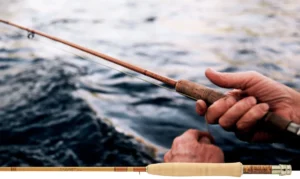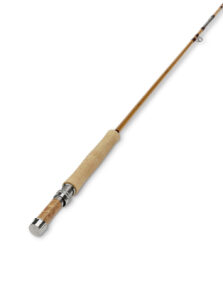
Trout Unlimited TU.org
Key Takeaways
-
Bamboo fly rods offer a traditional and organic feel, ideal for delicate presentations.
-
Fiberglass rods are making a comeback due to their durability and versatility.
-
Choosing between bamboo and fiberglass depends on stream size, fish species, and personal preference.
-
Bamboo rods are more expensive but provide a unique experience and require careful maintenance.
-
Fiberglass rods are more forgiving and suited for a variety of fishing techniques.
Choosing Your Companion for the Creeks: Fly Rod Materials
When you’re wading through the gentle currents of a small stream, the right fly rod becomes an extension of your arm. It’s not just about catching trout; it’s about the connection between you, the rod, and the water. And when it comes to small stream fishing, the materials of your rod matter just as much as your technique.
Material Science: Bamboo vs. Fiberglass Defined
Two contenders stand out when we talk about materials for fly rods: bamboo and fiberglass. Each has its own loyal following and for good reasons. Bamboo, the traditionalist’s pick, is all about the organic feel and the connection to the history of fly fishing. Fiberglass, on the other hand, is the comeback kid. It’s winning hearts with its durability and a modern twist on a classic action.
The Delicate Dance of Small Stream Fishing
Small stream fishing is an intimate affair. It’s you against the wily trout that know every pebble and current in their home. Stealth and precision are your best friends here. The right rod allows you to place your fly exactly where it needs to be without spooking the fish. But what makes a rod the ‘right’ rod? Let’s dive into the materials that could make or break your day on the stream.
The Traditionalist’s Choice: Bamboo Fly Rods
The Art of Bamboo
The craft of creating a bamboo fly rod is akin to an artist painting a masterpiece. Each rod is a work of art, and its aesthetics are as important as its functionality. The warm, natural hues of bamboo bring a sense of tradition to your grip, reminding you of the fly fishing legends who once stood in streams just like you.
Craftsmanship and Aesthetic
These rods aren’t mass-produced; they’re crafted. Each strip of bamboo is selected, cut, and shaped by hand. This painstaking process results in a rod that’s as beautiful to look at as it is to fish with. The nodes, the wraps, the varnish – each detail adds to the rod’s unique character.
The Feel of a Bamboo Rod in Action
But it’s not just about looks. When you cast a bamboo rod, you’ll feel every vibration as the line unfurls through the air. The rod’s natural flexibility allows for a slower, more deliberate cast, perfect for the kind of precise presentations that small stream fishing demands.
What You Pay for When You Buy Bamboo
The Cost of Craftsmanship
Quality comes at a price. Bamboo rods are often more expensive than their modern counterparts. But remember, you’re not just buying a fishing tool; you’re investing in a piece of angling heritage. A well-made bamboo rod can last a lifetime and become a family heirloom for many generations if treated right.
Longevity and Care for Your Bamboo Rod
Speaking of treatment, bamboo rods need love. You can’t just toss them in the back of your truck after a day on the water. They require regular maintenance, from keeping them dry to avoiding high temperatures. But treat them well, and they’ll be passing stories down to the next generation of anglers.
Ideal Conditions for Bamboo Rods
Now, bamboo isn’t for every situation. It shines in calm waters where the fish are easily spooked, and precision is key. If you’re targeting smaller trout in a serene brook or spring creek, a bamboo rod can be your secret weapon.
So, as you stand by the creek, the gentle whisper of the flowing water at your feet, think about what you’re holding in your hand. Is it a piece of history, a rod that connects you to the very soul of fly fishing? Or is it a modern marvel, a testament to the advancements in fishing technology? The choice between bamboo and fiberglass is more than just practical; it’s personal.
Tips for Casting with Bamboo
Casting with bamboo is an art form in itself. You need a gentle touch and a bit of patience. Start with a wider loop to accommodate the rod’s slower action, and let the rod do the work for you. Think of it as a dance: back, forth, and release when the rod tells you it’s time. It’s not about power; it’s about timing and finesse.
Modern Angling with Fiberglass Fly Rods
Fiberglass fly rods are experiencing a renaissance in the fishing world. Once overshadowed by the high-tech feel of graphite, fiberglass is now celebrated for its middle-ground virtues. It’s the Goldilocks of fly rods—not too stiff, not too soft, but just right for many anglers hitting the streams.
Why the resurgence? It’s simple. Fiberglass offers a blend of the past and the present, the traditional and the modern. It has a soulful flex that harkens back to the days of old but with the durability and versatility that today’s anglers demand.
The Resurgence of Fiberglass
So, what’s behind the growing popularity of fiberglass rods? They’re tough. They can take a beating and bounce back, ready for more. That’s a big deal when you’re clambering over rocks and through underbrush to reach those hidden spots where the trout lie in wait.
Why Fiberglass is Gaining Popularity
Fiberglass is gaining ground for several reasons. It’s nearly indestructible, making it a great choice for anglers who fish hard and put their gear to the test. It also has a nostalgic appeal, reminiscent of the golden age of fly fishing. Besides that, manufacturers are now producing fiberglass rods with contemporary components, creating a perfect marriage of retro appeal and modern performance.
Varieties of Fiberglass Rods
Today’s fiberglass rods come in all shapes and sizes. From nimble 3-weights ideal for tiny mountain streams to beefier models capable of handling larger waters and fish, there’s a fiberglass rod for every scenario. Some are even designed with specific fishing techniques in mind, like tight-looped nymphing or delicate dry fly presentations.
Advantages of Flexibility and Durability
One of the biggest advantages of fiberglass is its inherent flexibility. This quality gives it a smooth, parabolic bend that’s ideal for absorbing the thrashing runs of a hooked trout. Durability is another plus. Drop a fiberglass rod, step on it, even close it in the car door—it’ll likely survive the ordeal, ready to fish another day.
The Forgiving Nature of Fiberglass
Especially for those new to the sport, the forgiving nature of fiberglass is a godsend. Its slower action can be more tolerant of casting errors, which helps beginners get the hang of the rhythm and timing needed for effective fly casting. And when it comes to playing fish, that same flexibility reduces the risk of breaking off, giving anglers a better chance of landing their catch.
Caring for Your Fiberglass Rod
While fiberglass rods are tough, they still need care. After each outing, rinse your rod to remove any grit or grime. Check the ferrules and perhaps apply a light wax to ensure a snug fit. Store your rod in a cool, dry place, and it will be a faithful companion on many fishing adventures.
Fiberglass: The Versatile Performer
The versatility of fiberglass is hard to overstate. It’s as much at home on a high-mountain brook as it is on a coastal salt flat. This adaptability makes it a top choice for anglers who fish a variety of waters and target different species throughout the season.
Techniques Suited for Fiberglass
Whether you’re delicately dropping a dry fly onto a glassy pool or bouncing a nymph along the bottom of a fast-moving run, a fiberglass rod can handle it. The rod’s deep flex allows for a range of techniques, making it a multi-tool in your fishing arsenal.
Comparing Weight and Feel to Bamboo
Compared to bamboo, fiberglass is generally lighter and more responsive. It doesn’t have the same classic feel, but it offers a level of tactile feedback that many anglers appreciate. It’s a bit like driving a vintage car with a modern engine under the hood—classic vibes with the power and reliability of today’s technology.
Reeling It In: Rod Choice for Stream Success
Ultimately, choosing the right rod for small stream trout fishing is about matching your gear to the conditions and your personal style. It’s a decision that can elevate your fishing experience from frustrating to sublime.
Matching the Rod to the Stream
Consider the size of the stream and the average size of the trout you’re targeting. Small, tight streams with overhanging vegetation call for a shorter rod, while larger streams might allow for a longer rod that can handle a bit more line and deliver longer casts.
Assessing Stream Size and Fish Species
For smaller streams and trout, look for a rod that offers delicate presentations and can protect light tippets. Bamboo excels in these situations. For larger streams where you might encounter a mix of fish sizes and need more versatility, fiberglass is an excellent choice.
Understanding Rod Action and Line Weight Needs
Rod action—fast, medium, or slow—dictates how the rod will cast and how it will feel during the fight. Line weight is equally important; it should match the size of the flies you’re using and the fish you’re targeting. A 3 or 4-weight line is often perfect for small stream trout fishing, but always be ready to adjust based on the conditions.
The Angler’s Preference: What Feels Right
Most importantly, choose a rod that feels right to you. The best rod on paper might not be the best rod in your hands. It’s about comfort, confidence, and enjoyment. If you’re not sure, try casting a few different rods before making your decision. The right one will speak to you.
Personal Comfort with Rod Materials
Some anglers prefer the classic feel of bamboo, while others lean towards the modern sensibilities of fiberglass. There’s no right or wrong choice, only what works best for you and your fishing style.
Adapting Gear to Your Fishing Style
Your gear should complement your fishing style, not complicate it. If you love the art of fly fishing, a bamboo rod might be your muse. If you’re all about versatility and durability, fiberglass could be your workhorse. The key is to choose gear that helps you become a better angler.
Investment for the Future
A high-quality rod, whether bamboo or fiberglass, is an investment. It’s not just a purchase; it’s a commitment to the sport of fly fishing and a nod to the future of the tradition. By choosing wisely, you’re ensuring years of enjoyment on the water and a legacy of angling adventures.
Long-Term Value of High-Quality Rods
When you invest in a high-quality rod, you’re not just buying a tool; you’re buying years of reliable performance. A well-made rod can last for decades with proper care, making it a valuable part of your fishing gear collection.
Ensuring a Legacy of Angling Enjoyment
By choosing a rod that suits your needs and taking good care of it, you’re not just looking out for your own fishing success. You’re preserving a piece of angling culture that can be handed down to the next generation, inspiring future anglers to continue the tradition.
As you stand by the water’s edge, rod in hand, remember that every cast is a story in the making. Choose your rod wisely, and let those stories be as grand as the streams and the fish that call them home.
Understanding Rod Action and Line Weight Needs
Getting to grips with rod action and line weight is crucial for small stream success. A rod’s action can range from slow to fast, affecting how it bends and snaps back during the cast. Slow action rods bend deeply, ideal for the gentle presentation of flies on small streams. Line weight should be chosen based on the size of the trout you’re targeting; for small stream trout, a lighter line, like a 3 or 4-weight, often does the trick.
The Angler’s Preference: What Feels Right
When you pick up a rod, it should feel like an extension of your arm. The balance, the weight, the way it casts—it all needs to come together in a way that feels natural to you. It’s not just about the specs; it’s about how the rod feels when you’re using it.
Remember, a rod that’s perfect for one angler might not be right for another. It’s personal. That’s why testing different rods is so important. When you find the right one, you’ll know—it’s the rod that makes you feel like you can outsmart any trout in the stream.
Personal Comfort with Rod Materials
Are you drawn to the romance of a bamboo rod, or do you prefer the practicality of fiberglass? Your comfort with the material of your rod is as important as any technical specification. Bamboo brings a sense of tradition and a slower pace, while fiberglass offers a modern approach with a bit more resilience.
Adapting Gear to Your Fishing Style
Your fishing gear should adapt to you, not the other way around. If you’re meticulous and enjoy the slow art of fly presentation, a bamboo rod might suit you best. If you’re more about exploring and enduring the rough and tumble of the wild, fiberglass might be your ally. Your gear is your partner in the dance with trout—choose it wisely.
Investment for the Future
Investing in a quality rod is about more than the immediate joy of fishing—it’s about setting yourself up for years of rewarding experiences on the water. Whether you choose bamboo or fiberglass, you’re investing in something that can bring you countless hours of peace, excitement, and connection to nature.
Moreover, this isn’t just an investment in your own fishing endeavors; it’s an investment in the sport itself. By choosing a rod that will last, you’re contributing to the sustainability and legacy of fly fishing, ensuring that future generations can enjoy the same thrills and serenity that you do.
Long-Term Value of High-Quality Rods
A high-quality rod is more than a tool; it’s a companion for your fishing adventures. The right rod can last decades, becoming more valuable as the years go by—not just in monetary terms, but in the memories and experiences it helps to create.
Ensuring a Legacy of Angling Enjoyment
By selecting a rod that fits your needs and caring for it properly, you’re doing more than catching fish—you’re preserving a piece of the angling tradition. A well-loved rod can be passed down, its stories and secrets shared with the next generation, ensuring the legacy of fly fishing lives on.
Frequently Asked Questions
Before we cast off, let’s tackle some common queries about bamboo and fiberglass rods. These are the questions I hear most often from fellow anglers, and the answers might just help you make your decision.
Can Bamboo Rods Handle Big Trout?
Yes, bamboo rods can handle big trout, but it’s all about how you play the fish. Bamboo rods are strong but they flex a lot, so you need to be gentle and patient. Keep your line tight and let the rod’s natural elasticity absorb the fish’s energy.
Are Fiberglass Rods Suitable for Beginners?
-
Forgiving nature: Fiberglass rods are great for beginners because they’re more forgiving of mistakes.
-
Durability: They can take a knock or two, which is inevitable when you’re learning.
-
Cost-effective: Generally, they’re less expensive than high-end bamboo rods, making them a good entry-level option.
Fiberglass rods are a solid choice for beginners. They offer a good balance of feel and forgiveness, which can help novice anglers build their skills without becoming frustrated by a rod that’s too demanding.
What Is the Price Difference Between Bamboo and Fiberglass Rods?
Generally, bamboo rods are more expensive due to the labor-intensive process of making them. You can expect to pay several hundred to a few thousand dollars for a bamboo rod, while a good quality fiberglass rod can be found for a fraction of that cost. Remember, you’re paying for the art and tradition with bamboo, while fiberglass offers modern performance at a more accessible price point.
Can I Use the Same Techniques with Bamboo and Fiberglass Rods?
While many techniques overlap, the unique characteristics of bamboo and fiberglass rods may require slight adjustments. Bamboo rods excel with a slower casting rhythm and delicate presentations, whereas fiberglass rods can handle a wider range of techniques with their more forgiving action. Ultimately, the best technique is the one that feels right to you and works for the water you’re fishing.
And there you have it, the rundown on bamboo versus fiberglass rods for small stream trout fishing. Whichever path you choose, know that the perfect rod is out there, waiting to become a part of your fishing story. Tight lines and happy casting!

Trout Unlimited TU.org




